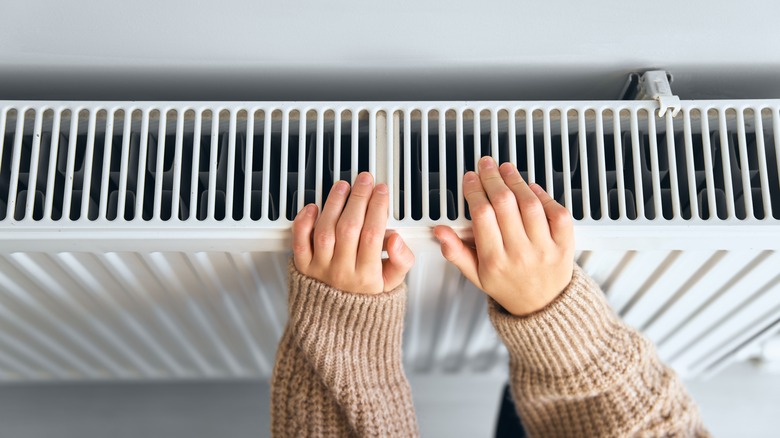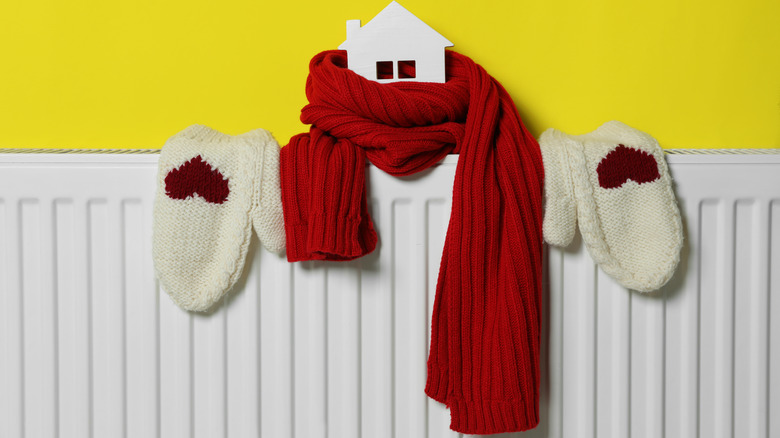Keep Your Heat Bill Down This Winter With This Easy To Find Product
We may receive a commission on purchases made from links.
The annual winter balancing act of trying to heat your home and avoid skyrocketing energy bills is something many of us are familiar with. There are various ways to save money on your heating bills. For instance, smart thermostats can save you money if used correctly. However, if you use radiators to heat your home, then there's another simple product which could help you reduce your energy bills. The product in question is a heat reflector (or radiator reflector). As the name suggests, it's designed to reflect heat that may otherwise be lost back into your home. Think of how kitchen foil reflects heat, and you get the picture of how these work.
The premise is simple, but does it work? The short answer is yes, in the right circumstances, these can help to achieve energy bill savings. We discuss what the right circumstances are in a little more detail later, but mainly, heat reflectors work best with radiators that are situated on external walls that are either uninsulated or poorly insulated. How much they will save is difficult to quantify, as it varies depending on factors like size, number of radiators, and insulation. However, the UK-based Energy Saving Trust estimates that in the UK and Ireland, fitting reflectors on external insulated walls will save around £25 annually (about $32.94 at the time of writing). Not huge savings, but every cent counts.
Let's have a closer look at radiator reflectors, how they work, and some of the available options.
The physics behind radiators and heat reflectors
Despite their name, most radiators produce the majority of heat not through radiation but through convection. The actual percentages can vary depending on the type of radiator, but typically, this can vary from over 50 percent to 90 percent of a radiator's heat being produced through convection. This is important, as radiator reflectors only reflect the "radiant" portion of the heat. A quick physics lesson on the properties of these different forms of heat energy can help explain this. Put simply, convection warms the air, which then circulates around the room, while radiation travels in straight lines directly from a hot surface. If you think of how you can still feel the warmth of a winter sun despite a chilly wind, then you're in the ballpark.
This is why radiator reflectors work best when there's a clear line of sight between the radiator and the wall. It also explains why their benefits are restricted to the portion of heat that radiates outwards rather than the bulk that moves through the air. While physics definitely has a detrimental effect on the effectiveness of heat reflectors, they can still help to reduce energy bills in the right circumstances. It's also worth noting that the US Department of Energy recommends installing reflectors behind all radiators mounted to external walls.
Now, before you go and superglue aluminum foil to the walls behind your radiators, let's have a look at why this isn't a great idea and some of the better options that can be used.
Installing a radiator reflector
It's understandable if your first thought is to reach for the aluminum foil, but hold back on that idea for a couple of reasons. Firstly, aluminum foil lacks the insulation layer present in good radiator reflectors. For instance, Sealtech Radiant Barrier insulation roll has a choice of insulation layers going from 3 mm to 10 mm, and reflects 95 percent of radiant energy. The second reason to avoid household foil is its fragility; it tends to tear, wrinkle, and can be difficult to keep in place. That being said, it is possible to DIY a system by attaching aluminum foil to a suitable backing material that will add the solidity and insulating properties needed to make it a worthwhile exercise.
Another option is to opt for a roll of material like the aforementioned Sealtech product. Reflective foil insulations like this can be tailored to fit precisely to each radiator. It also has the added benefit of being multipurpose and can be used anywhere in the house where a little extra insulation or radiant heat reflection is required, including helping to insulate your garage door. Another possibility is to opt for a kit like the Radflek Radiator Reflector set. This is easy to install, reflects 95 percent of the radiated heat, and one pack will fit up to 6 radiators, depending on their size.
The savings might not be huge, but if you're home would benefit from these, then heat reflectors might help you stay a degree or two warmer in the winter months.


